Simulation of the GOx/GCH4 Multi-Element Combustor Including the Effects of Radiation and Algebraic Variable Turbulent Prandtl Approaches
Abstract
:1. Introduction
2. The Test Case
3. Numerical Setup
3.1. Simulation Domain
3.2. Numerical Models
4. Results and Discussion
4.1. Combustion Model Effect
4.2. Radiative Heat Transfer Modeling
4.3. Turbulent Prandtl Number Effect
4.4. Turbulence Modeling Study
4.5. General Considerations
5. Conclusions
Author Contributions
Funding
Conflicts of Interest
References
- Silvestri, S.; Celano, M.P.; Schlieben, G.; Haidn, O.J. Characterization of a Multi-Injector Gox-Gch4 Combustion Chamber. In Proceedings of the 52nd AIAA/SAE/ASEE Joint Propulsion Conference, Salt Lake City, UT, USA, 25–27 July 2016. [Google Scholar]
- Silvestri, S.; Kirchberger, C.; Schlieben, G.; Celano, M.P.; Haidn, O. Experimental and Numerical Investigation of a Multi-Injector GOX-GCH4 Combustion Chamber. Trans. Jpn. Soc. Aeronaut. Space Sci. Aerosp. Technol. Jpn. 2018, 16, 374–381. [Google Scholar] [CrossRef] [Green Version]
- Roth, C.M.; Haidn, O.J.; Chemnitz, A.; Sattelmayer, T.; Frank, G.; Müller, H.; Zips, J.; Keller, R.; Gerlinger, P.M.; Maestro, D. Numerical investigation of flow and combustion in a single element GCH4/GOx rocket combustor. In Proceedings of the 52nd AIAA/SAE/ASEE Joint Propulsion Conference, Salt Lake City, UT, USA, 25–27 July 2016; p. 4995. [Google Scholar]
- Chemnitz, A.; Sattelmayer, T.; Roth, C.; Haidn, O.; Daimon, Y.; Keller, R.; Gerlinger, P.; Zips, J.; Pfitzner, M. Numerical Investigation of Reacting Flow in a Methane Rocket Combustor: Turbulence Modeling. J. Propuls. Power 2018, 34, 864–877. [Google Scholar] [CrossRef]
- Maestro, D.; Cuenot, B.; Chemnitz, A.; Sattelmayer, T.; Roth, C.; Haidn, O.J.; Daimon, Y.; Keller, R.; Gerlinger, P.M.; Frank, G.; et al. Numerical Investigation of Flow and Combustion in a Single-Element GCH4/GOX Rocket Combustor: Chemistry Modeling and Turbulence-Combustion Interaction. In Proceedings of the 52nd AIAA/SAE/ASEE Joint Propulsion Conference, Salt Lake City, UT, USA, 25–27 July 2016. [Google Scholar] [CrossRef] [Green Version]
- Perakis, N.; Rahn, D.; Haidn, O.J.; Eiringhaus, D. Heat Transfer and Combustion Simulation of Seven-Element O2/CH4 Rocket Combustor. J. Propuls. Power 2019, 35, 1080–1097. [Google Scholar] [CrossRef]
- Perakis, N.; Strauß, J.; Haidn, O.J. Heat flux evaluation in a multi-element CH4/O2 rocket combustor using an inverse heat transfer method. Int. J. Heat Mass Transf. 2019, 142, 118425. [Google Scholar] [CrossRef]
- Perakis, N.; Haidn, O.J.; Eiringhaus, D.; Rahn, D.; Zhang, S.; Daimon, Y.; Karl, S.; Horchler, T. Qualitative and Quantitative Comparison of RANS Simulation Results for a 7-Element GOX/GCH4 Rocket Combustor. In Proceedings of the 54th AIAA/SAE/ASEE Joint Propulsion Conference, Cincinnati, OH, USA, 9–11 July 2018; p. 54. [Google Scholar]
- Nasuti, F.; Concio, P.; Indelicato, G.; Lapenna, P.E.; Creta, F. Role of Combustion Modeling in the Prediction of Heat Transfer in LRE Thrust Chambers. In Proceedings of the 8th European Conference for Aeronautics and Aerospace Sciences (EUCASS), Madrid, Spain, 1–4 July 2019. [Google Scholar]
- Zhukov, V.P. Computational Fluid Dynamics Simulations of a GO2/GH2 Single Element Combustor. J. Propuls. Power 2015, 31, 1–8. [Google Scholar] [CrossRef] [Green Version]
- Zhukov, V.P.; Suslov, D.I. Measurements and modelling of wall heat fluxes in rocket combustion chamber with porous injector head. Aerosp. Sci. Technol. 2016, 48, 67–74. [Google Scholar] [CrossRef]
- Poschner, M.; Pfitzner, M. Real Gas CFD Simulation of Supercritical H2-LOX in the MASCOTTE Single Injector Combustor Using a Commercial CFD Code. In Proceedings of the 46th AIAA Aerospace Sciences Meeting and Exhibit, Reno, Nevada, 7–10 January 2008; Volume 46. [Google Scholar] [CrossRef]
- Molchanov, A.M.; Bykov, L.V.; Nikitin, P.V. Modeling High-Speed Reacting Flows with Variable Turbulent Prandtl and Schmidt Numbers. In Proceedings of the 9th International Conference on Heat Transfer, Fluid Mechanics and Thermodynamics, Valletta, Malta, 16–18 July 2012. [Google Scholar]
- Yimer, I.; Campbell, I.; Jiang, L.-Y. Estimation of the Turbulent Schmidt Number from Experimental Profiles of Axial Velocity and Concentration for High-Reynolds-Number Jet Flows. Can. Aeronaut. Space J. 2002, 48, 195–200. [Google Scholar] [CrossRef]
- He, G.; Guo, Y.; Hsu, A.T. The effect of Schmidt number on turbulent scalar mixing in a jet-in-crossflow. Int. J. Heat Mass Transf. 1999, 42, 3727–3738. [Google Scholar] [CrossRef]
- Keistler, P.; Xiao, X.; Hassan, H.; Rodriguez, C. Simulation of Supersonic Combustion Using Variable Turbulent Prandtl/Schmidt Number Formulation. In Proceedings of the 36th AIAA Fluid Dynamics Conference and Exhibit, San Francisco, CA, USA, 5–8 June 2006. [Google Scholar]
- Ivancic, B.; Riedmann, H.; Frey, M.; Knab, O.; Karl, S.; Hannemann, K. Investigation of Different Modeling Approaches for CFD Simulation of High Pressure Rocket Combustors. In Proceedings of the 5th European Conference for Aerospace Sciences (EUCASS), Munich, Germany, 1–5 July 2013. [Google Scholar]
- Xiao, X.; Edwards, J.; Hassan, H.; Cutler, A. A Variable Turbulent Schmidt Number Formulation for Scramjet Application. In Proceedings of the 43rd AIAA Aerospace Sciences Meeting and Exhibit, Reno, Nevada, 10–13 January 2005. [Google Scholar] [CrossRef] [Green Version]
- Goldberg, U.C.; Palaniswamy, S.; Batten, P.; Gupta, V. Variable Turbulent Schmidt and Prandtl Number Modeling. Eng. Appl. Comput. Fluid Mech. 2010, 4, 511–520. [Google Scholar] [CrossRef]
- Thellmann, A. Impact of Gas Radiation on Viscous Flows, in Particular on Wall Heat Loads, in Hydrogen-Oxygen vs. Methane-Oxygen Systems, Based on the SSME Main Combustion Chamber. Ph.D. Thesis, Universitaet der Bundeswehr, Muenchen, Germany, 2010. [Google Scholar]
- Leccese, G.; Bianchi, D.; Nasuti, F. Numerical Investigation on Radiative Heat Loads in Liquid Rocket Thrust Chambers. J. Propuls. Power 2019, 35, 930–943. [Google Scholar] [CrossRef]
- Molchanov, A.M.; Bykov, L.V.; Yanyshev, D.S. Calculating thermal radiation of a vibrational nonequilibrium gas flow using the method of k-distribution. Thermophys. Aeromech. 2017, 24, 399–419. [Google Scholar] [CrossRef]
- Mazzei, L.; Puggelli, S.; Bertini, D.; Pampaloni, D.; Andreini, A. Modelling soot production and thermal radiation for turbulent diffusion flames. Energy Procedia 2017, 126, 826–833. [Google Scholar] [CrossRef]
- Poitou, D.; El Hafi, M.; Cuenot, B. Analysis of Radiation Modeling for Turbulent Combustion: Development of a Methodology to Couple Turbulent Combustion and Radiative Heat Transfer in LES. J. Heat Transf. 2011, 133, 062701. [Google Scholar] [CrossRef] [Green Version]
- Daimon, Y.; Negishi, H.; Silvestri, S.; Haidn, O.J. Conjugated Combustion and Heat Transfer Simulation for a 7 element GOX/GCH4 Rocket Combustor. In Proceedings of the 54th AIAA/SAE/ASEE Joint Propulsion Conference, Cincinnati, OH, USA, 9–11 July 2018; pp. 2018–4553. [Google Scholar]
- Muto, D.; Daimon, Y.; Shimizu, T.; Negishi, H. Wall modeling of reacting turbulent flow and heat transfer in liquid rocket engines. In Proceedings of the 54th AIAA/SAE/ASEE Joint Propulsion Conference, Cincinnati, OH, USA, 9–11 July 2018. [Google Scholar] [CrossRef]
- Balaras, E.; Benocci, C.; Piomelli, U. Two-layer approximate boundary conditions for large-eddy simulations. AIAA J. 1996, 34, 1111–1119. [Google Scholar] [CrossRef]
- Rani, S.L.; Smith, C.E.; Nix, A.C. Boundary-Layer Equation-Based Wall Model for Large-Eddy Simulation of Turbulent Flows with Wall Heat Transfer. Numer. Heat Transfer Part B Fundam. 2009, 55, 91–115. [Google Scholar] [CrossRef]
- Kawai, S.; Larsson, J. Wall-modeling in large eddy simulation: Length scales, grid resolution, and accuracy. Phys. Fluids 2012, 24, 15105. [Google Scholar] [CrossRef]
- Piomelli, U. Wall-layer models for large-eddy simulations. Prog. Aerosp. Sci. 2008, 44, 437–446. [Google Scholar] [CrossRef]
- Larsson, J.; Kawai, S.; Bodart, J.; Bermejo-Moreno, I. Large eddy simulation with modeled wall-stress: Recent progress and future directions. Mech. Eng. Rev. 2016, 3, 1–23. [Google Scholar] [CrossRef] [Green Version]
- Maheu, N.; Moureau, V.; Domingo, P.; Duchaine, F.; Balarac, G. Large-Eddy Simulations of flow and heat transfer around a low-Mach number turbine blade. Center for Turbulence Research. In Proceedings of the Summer Program, Stanford, CA, USA, 24 June–20 July 2012. [Google Scholar]
- Ansys. CFX Theory Guide; ANSYS Inc.: Canonsburg, PA, USA, 2019; Volume 15317, p. R2. [Google Scholar]
- Yoder, D.A. Comparison of Turbulent Thermal Diffusivity and Scalar Variance Models. In Proceedings of the 54th AIAA Aerospace Sciences Meeting, San Diego, CA, USA, 4–8 January 2016; p. 54. [Google Scholar] [CrossRef] [Green Version]
- Kays, W.M.; Whitelaw, J.H. Convective Heat and Mass Transfer. J. Appl. Mech. 1967, 34, 254. [Google Scholar] [CrossRef]
- Wassel, A.; Catton, I. Calculation of turbulent boundary layers over flat plates with different phenomenological theories of turbulence and variable turbulent Prandtl number. Int. J. Heat Mass Transf. 1973, 16, 1547–1563. [Google Scholar] [CrossRef]
- Centeno, F.R.; Da Silva, C.V.; Brittes, R.; França, F.H.R. Numerical simulations of the radiative transfer in a 2D axisymmetric turbulent non-premixed methane–air flame using up-to-date WSGG and gray-gas models. J. Braz. Soc. Mech. Sci. Eng. 2015, 37, 1839–1850. [Google Scholar] [CrossRef]
- Ansys. Fluent Theory Guide; ANSYS Inc.: Canonsburg, PA, USA, 2019; Volume 15317, p. R2. [Google Scholar]
- Peters, N. Laminar diffusion flamelet models in non-premixed turbulent combustion. Prog. Energy Combust. Sci. 1984, 10, 319–339. [Google Scholar] [CrossRef]
- Magnussen, B.; Hjertager, B. On Mathematical Modeling of Turbulent Combustion with Special Emphasis on Soot Formation and Combustion. Symp. (Int.) Combust. Camb. Mass. 1977, 16, 719–729. [Google Scholar] [CrossRef]
- Rocket Propulsion Analysis, Version 2.3 User Manual. Cologne, Germany. 2017. Available online: http://www.propulsion-analysis.com/ (accessed on 5 April 2020).
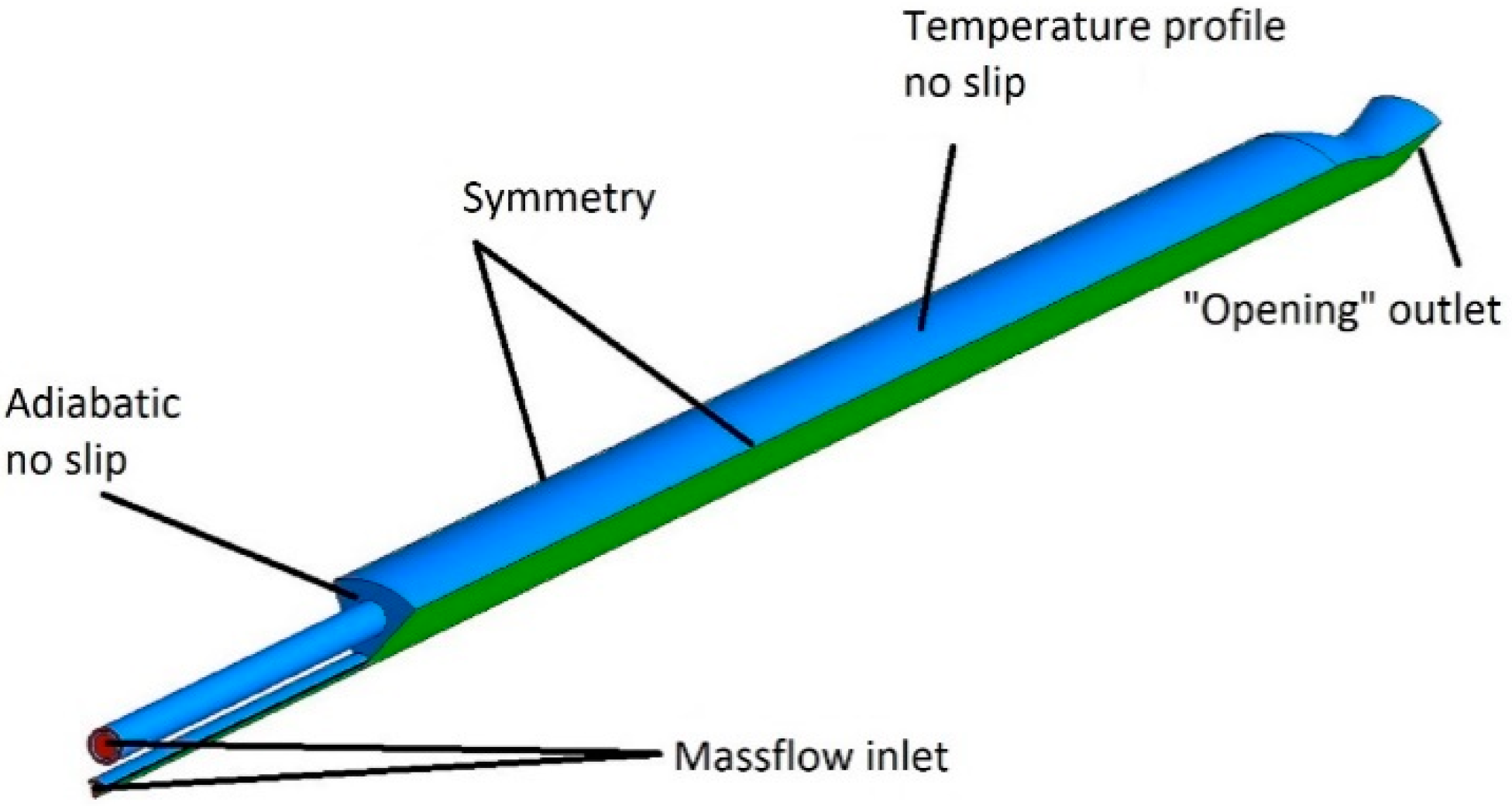

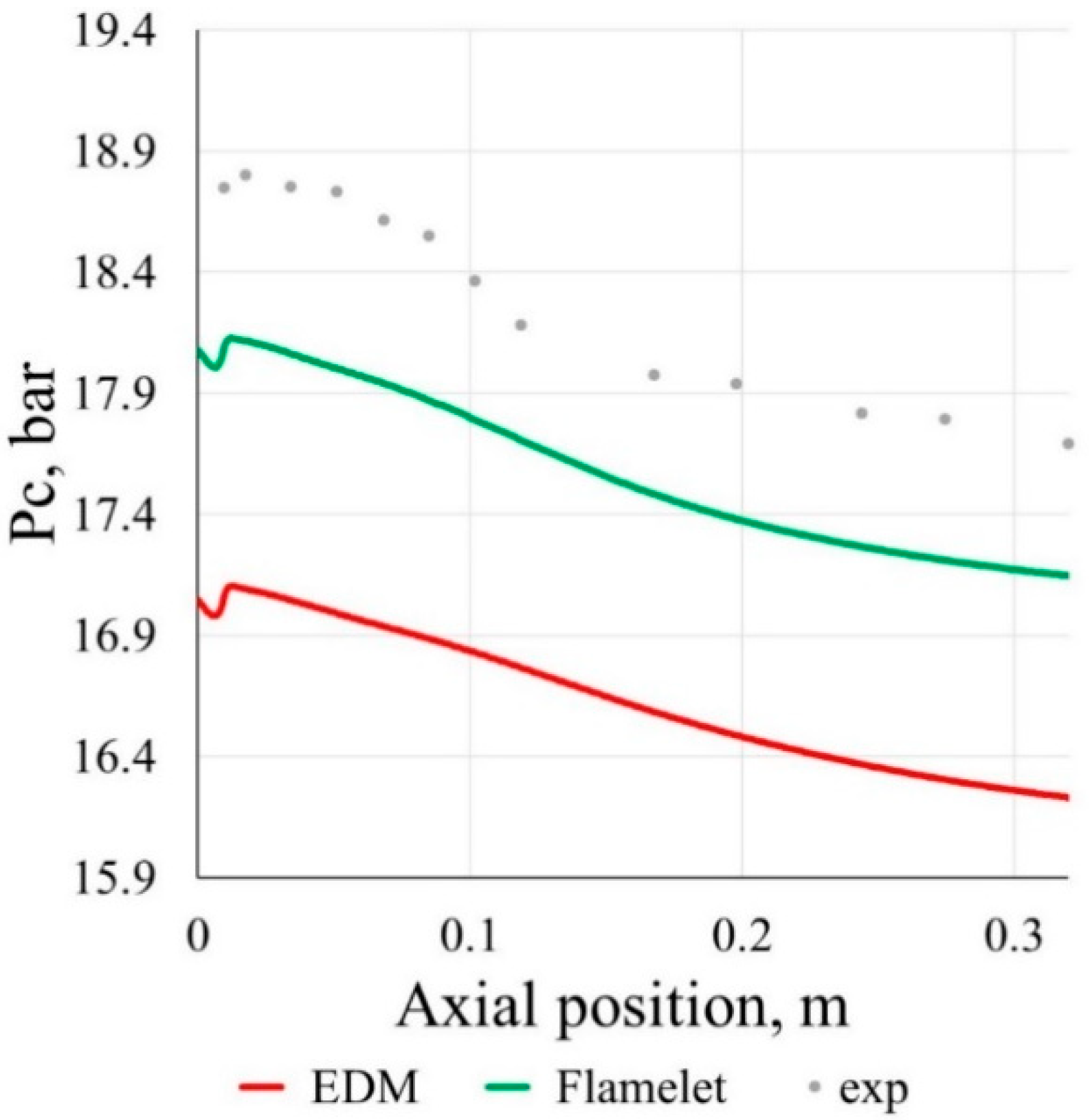














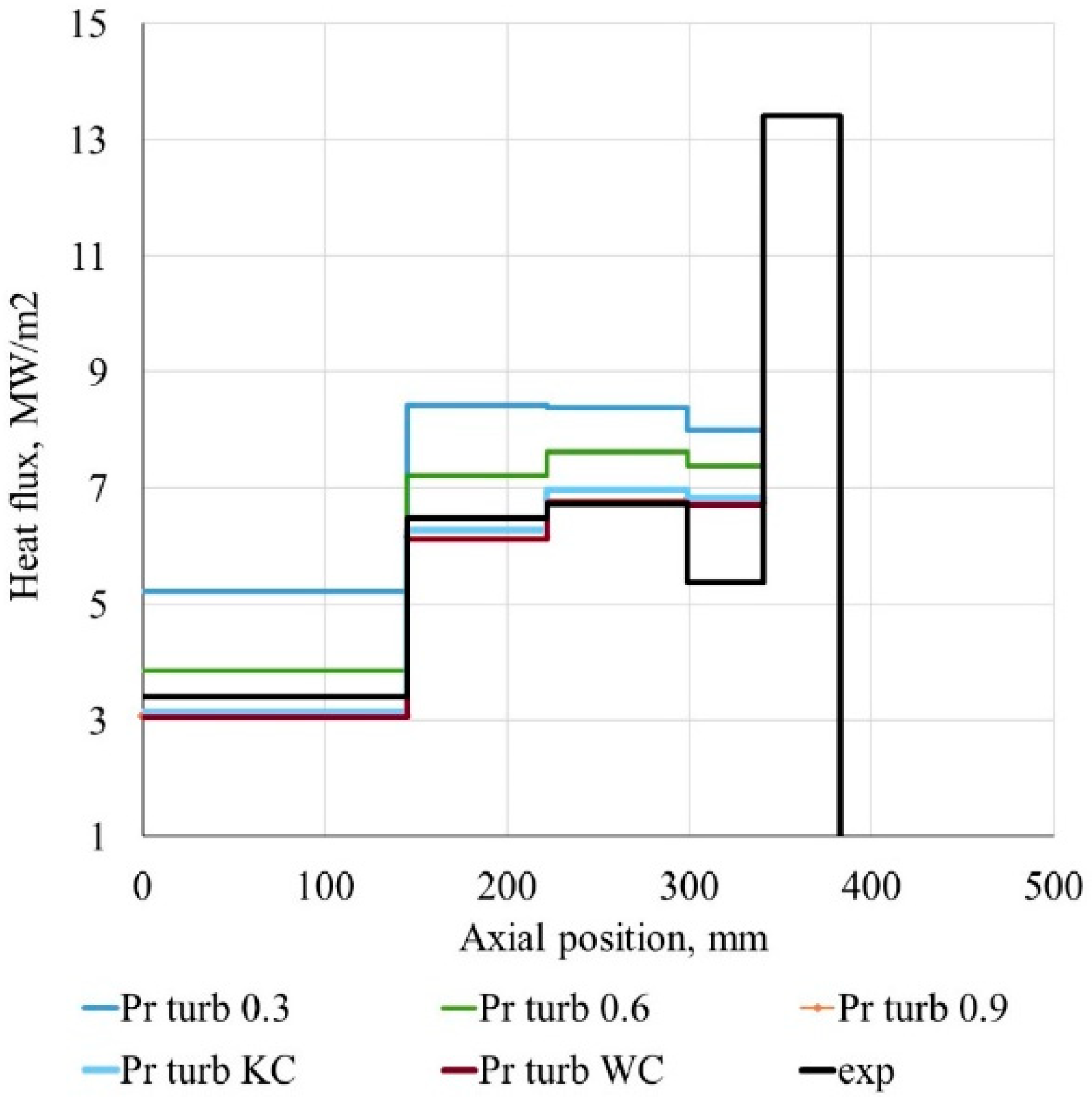





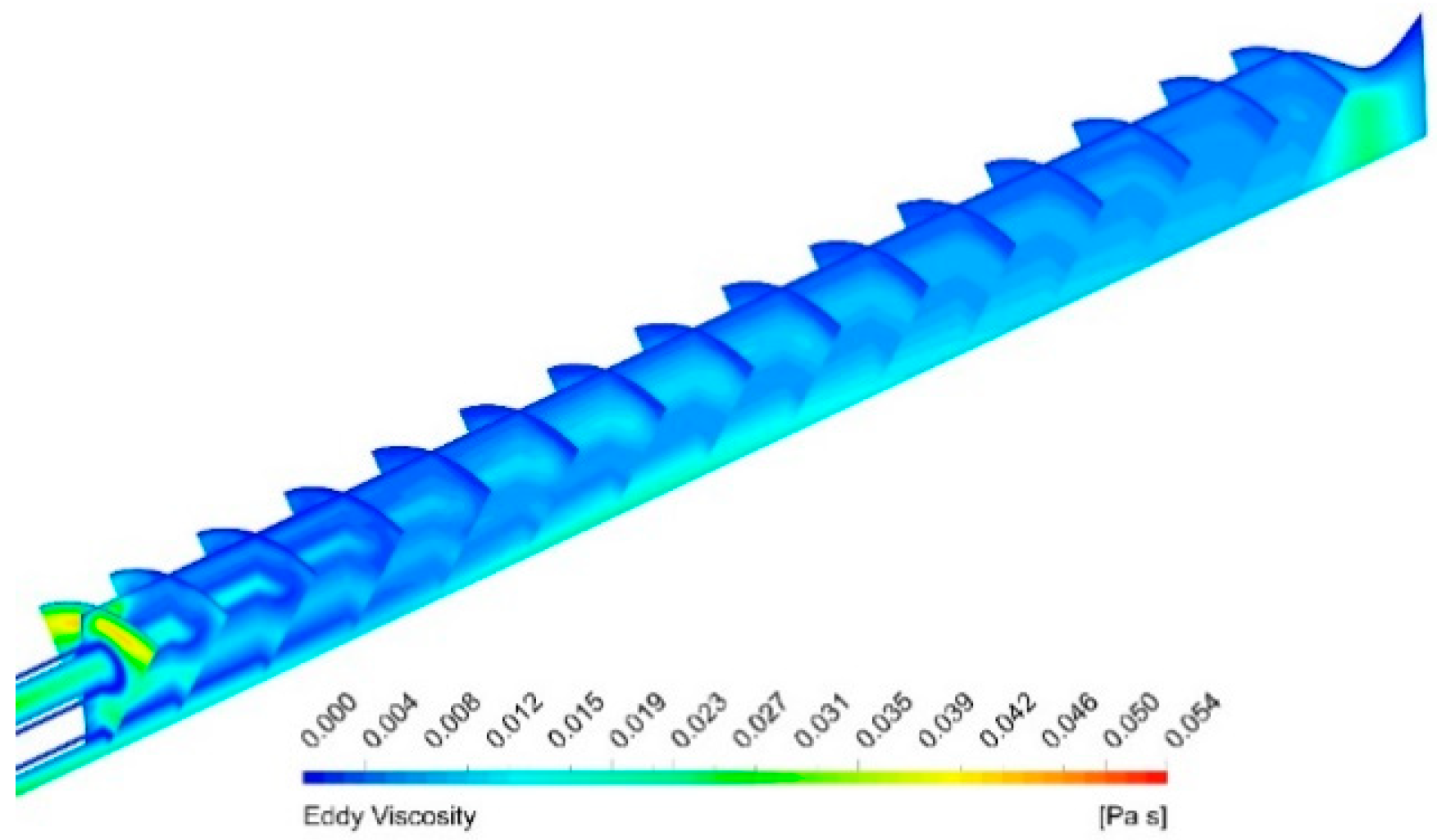
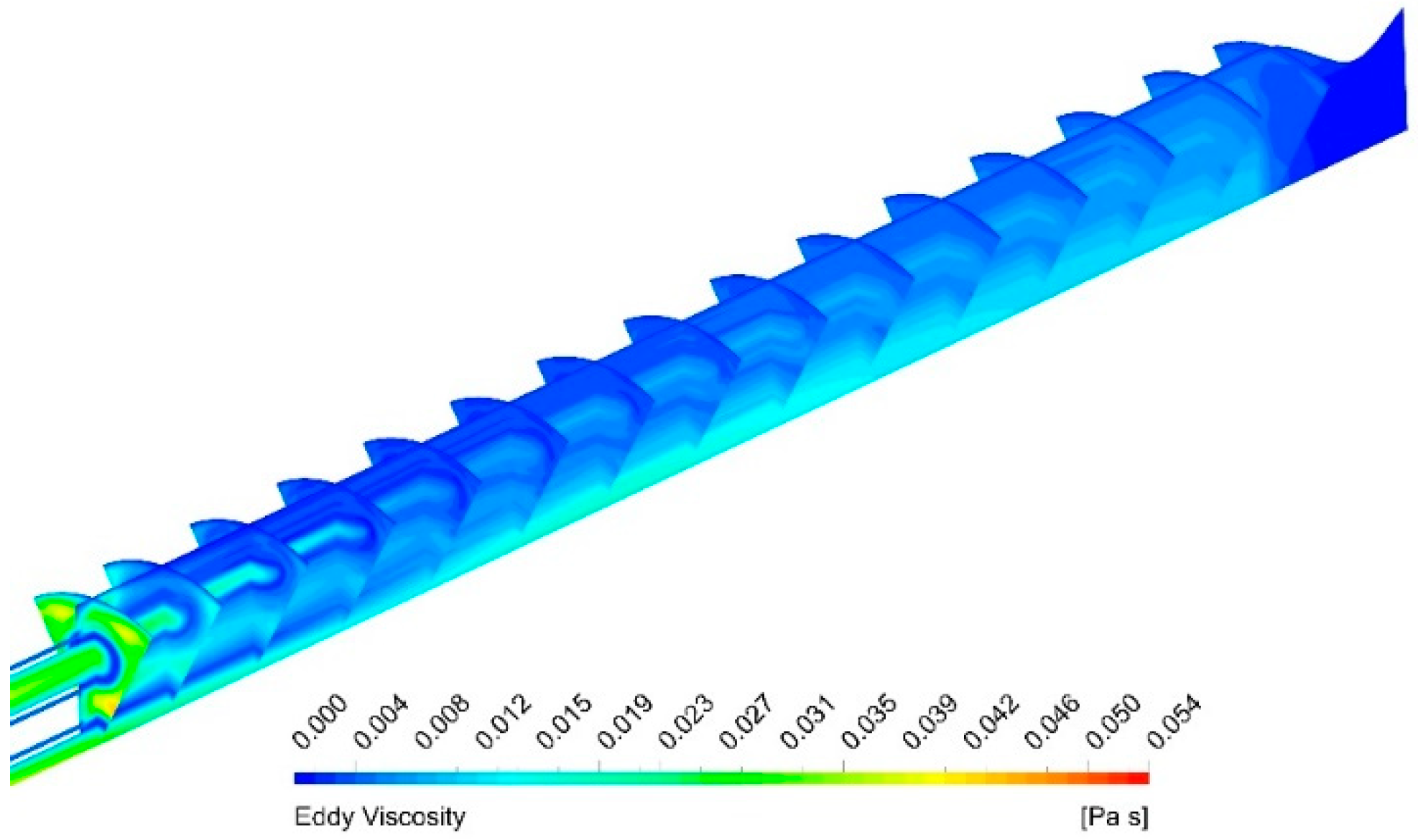


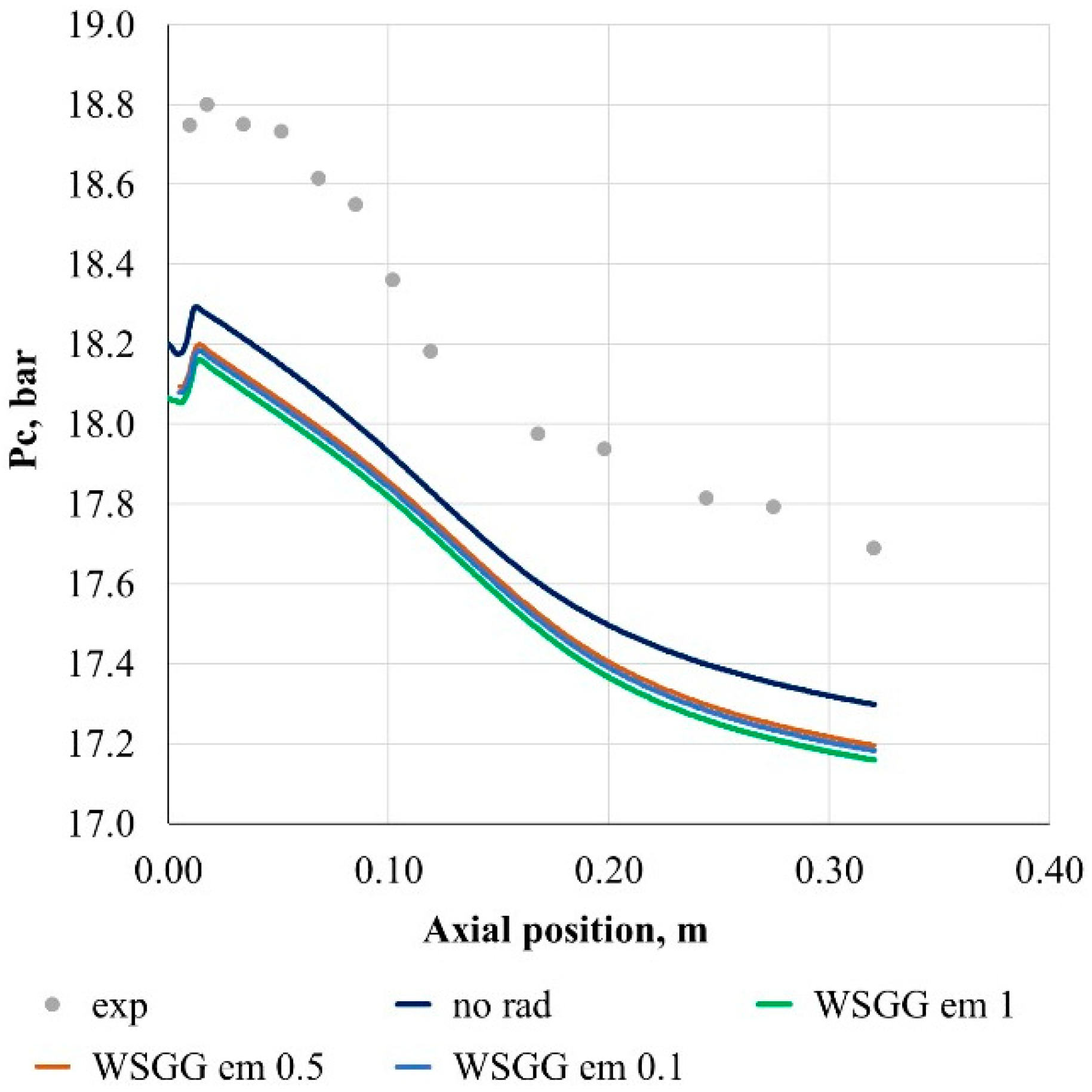
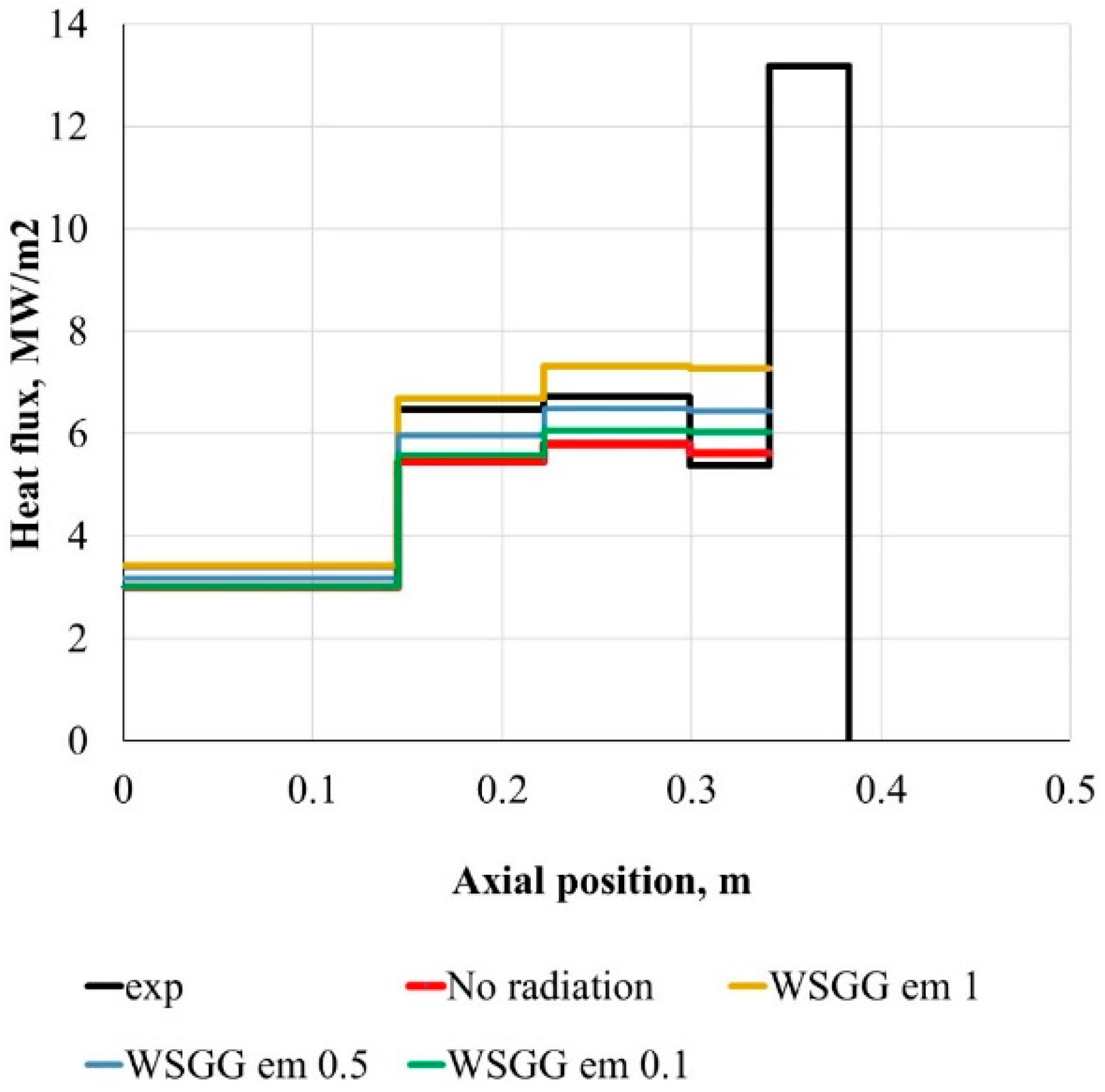
| Criterion | Coarse (1st) | 2nd | 3rd | 4th | Fine (5th) |
|---|---|---|---|---|---|
| Num. of cells, mio. | 0.8017 | 1.708 | 2.503 | 3.2803 | 6.92 |
| Max. pressure, bar | 16.38 | 17.32 | 17.59 | 17.65 | 17.72 |
| Integral WHF, MW | 0.151 | 0.157 | 0.1612 | 0.1621 | 0.1625 |
| Relative error, max pressure % | ---/--- | 5.43 | 1.53 | 0.34 | 0.40 |
| Relative error, integral WHF % | ---/--- | 3.82 | 2.61 | 0.56 | 0.25 |
| Radiation Model | ||||
|---|---|---|---|---|
| No Rad | Gray | WSGG 4 Gases | Exp | |
| Integral, MW | 0.1293 | 0.193 | 0.16542 | 0.16 |
| Radiative/Total | --- | 0.3221 | 0.208 | --- |
| Criterion | Turbulent Prandtl Number | |||||
|---|---|---|---|---|---|---|
| 0.3 | 0.6 | 0.9 | KC | WC | Exp | |
| Integral, MW | 0.2247 | 0.189 | 0.16248 | 0.16542 | 0.1614 | 0.16 |
| Radiative/Total | 0.184 | 0.198 | 0.208 | 0.208 | 0.209 | - |
| Criterion | Wall Emissivity | ||||
|---|---|---|---|---|---|
| 0.1 | 0.5 | 1 | No Radiation | Exp | |
| Integral, MW | 0.1494 | 0.159060 | 0.177240 | 0.144780 | 0.16 |
| Radiative/Total | 0.0187 | 0.077 | 0.174 | --- | --- |
© 2020 by the authors. Licensee MDPI, Basel, Switzerland. This article is an open access article distributed under the terms and conditions of the Creative Commons Attribution (CC BY) license (http://creativecommons.org/licenses/by/4.0/).
Share and Cite
Strokach, E.; Borovik, I.; Haidn, O. Simulation of the GOx/GCH4 Multi-Element Combustor Including the Effects of Radiation and Algebraic Variable Turbulent Prandtl Approaches. Energies 2020, 13, 5009. https://doi.org/10.3390/en13195009
Strokach E, Borovik I, Haidn O. Simulation of the GOx/GCH4 Multi-Element Combustor Including the Effects of Radiation and Algebraic Variable Turbulent Prandtl Approaches. Energies. 2020; 13(19):5009. https://doi.org/10.3390/en13195009
Chicago/Turabian StyleStrokach, Evgenij, Igor Borovik, and Oscar Haidn. 2020. "Simulation of the GOx/GCH4 Multi-Element Combustor Including the Effects of Radiation and Algebraic Variable Turbulent Prandtl Approaches" Energies 13, no. 19: 5009. https://doi.org/10.3390/en13195009







